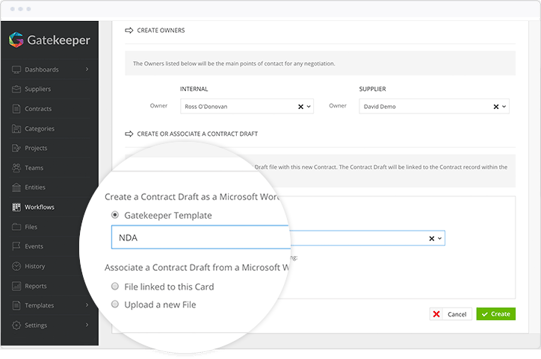

Contracting standards are a formalisation of the positions an organisation might and should take in respect of many aspects of contracts it arranges with third parties.
These standards can be embodied in the form of:
The content and settings of clauses in most contracts can be subject to negotiation. Since divergence and conflict are common during negotiations, having pre-set contracting standards can accelerate getting to a conclusion. If that conclusion is not as positive as desired, the amount of divergence can be calculated, and the level of attendant risk noted and tracked.
Contracting standards cannot be set-and-forget. Their targets and settings will be based on the circumstances in force at the time. All of those circumstances will likely have different lifetimes."
This means updates will be necessary from time to time, to improve the viability of the standards and the relevance of their settings, to take advantage of improvements in practices and technologies, to accommodate changes in the regulatory environment, and to better cater for the unexpected.
If it’s been more than six months since your contracting standards were last reviewed, you really should plan to do so as soon as possible.
This article will cover:
The updating frequency of contracting standards has typically been fairly relaxed, as the rate of external change and its span were quite manageable. You just needed to chip away at the updating process every so often to prevent falling behind.
The last few years have seen a rapid acceleration of change and uncertainty. It’s possible that more time has been spent dealing directly with the implications of this acceleration than maintaining the housekeeping schedule for updating the standards.
For some, the take-up of constantly improving Contract Management technologies has helped drive the updating of standards as it’s a requirement for the implementation of those technologies.
Since only a relatively small proportion of organisations have adopted any sophisticated technologies to help manage their contracts, the likelihood is that many of the remaining organisations are using outdated standards.
This might not have been of any real consequence for most organisations prior to the advent of the Covid-19 pandemic.
The incredible consequences of Covid-19, and government responses to it, have exposed serious deficiencies in the scope, viability and ongoing relevance of many organisations’ contracting standards."
One key learning for businesses from the pandemic is that existing contracts need to be urgently updated to better deal with the scale of complexity, uncertainty, volatility and ambiguity experienced through 2020, and the massive dislocation and disruption caused.
Doing this effectively is dependent on a thorough review, modernisation and updating of contracting standards. These updates can help to minimise risk in all new contracts.
With everyone essentially in the same boat contract-wise, vested self-interest if nothing else should ensure that there will be some take-up of any measures that can help defend against the contract situations people have found themselves bumping up against.
In any sink-or-swim situation, self-preservation trumps principle. It’s in our genes. It’s survival of the fittest in action.
Very broadly, there can be up to four elements in a contracting standards review.
1. Core issue analysis
Contracting standards are typically designed as a response to various types of constraints and risks. As discussed above, these mainly external core issues can come and go over time and can cyclically strengthen or weaken. Their effects on contract outcomes can be immediate and obvious, or slow and subtle.
As an example, a common core issue is the inability of suppliers to ship ordered products to customers in other countries. There can be a number of reasons for this, which may or may not be relevant when considering how to respond to the issue.
Devising a contractual response to these core issues and their effects, and gauging the efficacy of any response, can be difficult. Fine-tuning can be expected, based on actual performance. Any response that clearly aggravates the situation should be dealt with promptly.
It’s a worthwhile practice to record details of the core issues the first time that contracting standards are established and at every subsequent review.
This activity not only provides the rationale for the standard responses that were produced at the time, but also allows a comparison at the next review of how the core issues have changed in the interim.
2. Clause library examination
If a clause library exists:
3. Contract template library assessment
If a contract template library exists:

4. Contracting standards update
A contracting standards review can propose a varying number of recommendations, from zero upwards. It all depends on the scale, scope and speed of change between the previous and the current circumstances.
Given the potential consequences of inadequately updating the contracting standards, all proposed changes need to be reviewed and approved prior to implementation, by experienced people not involved in the standards update.
Any changes to the recommendations should be clearly documented, for use in the next contracting standards review. Once approved, the recommendations should be promptly implemented and made available to all who need to know.
While the contracting standards review is a fairly straightforward process, it can be complicated by:
These complications are manageable but can increase the review effort and duration.
In his 2016 TED Talk “The Surprising Habits of Original Thinkers”, psychologist Adam Grant discussed two of those habits that can help when reviewing your contracting standards:
Your contracting standards, the actual clauses and their preferred, alternative and fallback settings, are the defaults in Adam Grant’s terms."
So, how do you doubt the default? In general, it’s by considering two aspects of a standard:
Remember: this isn’t rocket science.
A gut feel or anecdotal evidence will suffice if useful numbers or details aren’t being kept, but that situation should be rectified as soon as possible because it can be a great help if and when those in the know move on or move out.
The key to dealing with uncertainty is to focus on its actual, probable and possible effects, rather than its causes.
Say a supplier can’t deliver what was ordered by the date promised. The reasons could include a shortage of raw materials, a locked-down workforce or strike, a government embargo on overseas transport, or all of the above.
A contract’s typical responses to a non-delivery event might include non-performance penalties, temporary suspension of obligations under force majeure, or termination of the contract if time is of the essence or a specific delivery date has been agreed.
These responses may not help the customer all that much because they’re not solving the fundamental problem of non-delivery.
In such cases, and many others, the contract needs to deal with the effects of any uncertainty by including clauses or options that can help to get around those effects."
Some general effects-triggered options that can increase uncertainty-readiness include:
These types of clauses should be discussed with some key suppliers to check for practicality and acceptability in terms of intent and how they are to be activated and deactivated. They can be then included as standards in the clause libraries and contract template libraries.
Given the circumstances laid bare by the pandemic, there’s evidence to suggest that many of our contracts are somewhat like your classic fair-weather sailor: a danger to themselves and others when the seas get rough and the going gets tough.
Those contracts seem to have been written for the good times. Being generous, these could be explained as failures of imagination or anticipation, but more harshly, as complacency or rote. It doesn’t really matter at this point. What’s done is done, but it can’t continue.
Updating contracting standards, making them more uncertainty-ready and resilient, is a good start. Those standards can then be applied for all new contracts, and retrofitted to at least all key and important contracts, either pre-emptively as soon as possible or as they approach renewal.
Remember though that your contracting standards are subject to negotiation and won’t be acceptable in all circumstances or to all suppliers.
Whether or not that’s acceptable to you depends on your risk appetite and the availability of realistic alternative options and/or suppliers.
As the old saying goes: You pays your money and you takes your choice.
That’s a standard that doesn’t need updating.
If you would like more information about how to manage your contracting standards, or how Gatekeeper can assist with those activities, then contact us today
Ready to improve your contract & vendor management?
.png)
.png)
.png)
-4.png)
Before Gatekeeper, our contracts
Anastasiia Sergeeva, Legal Operations Manager, BlaBlaCar
were everywhere and nowhere.
Gatekeeper is that friendly tap on the shoulder,
Donna Roccoforte, Paralegal, Hakkasan Group
to remind me what needs our attention.
Great System. Vetted over 25 other systems
Randall S. Wood, Associate Corporate Counsel, Cricut
and Gatekeeper rose to the top.
Thank you for requesting your demo.
Next Step - Book a Call
Please book a convenient time for a quick call to discuss your requirements.